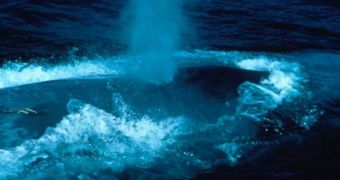According to a group of environmentalists from the US National Oceanic and Atmospheric Administration (NOAA), the great blue whales, the largest animals to have ever lived on the planet, are beginning to reestablish their migration patterns around the globe. These lanes were disrupted by excessive human activity and irresponsible and unsustainable hunting, which caused a significant drop in the number of whales traveling them. A group of the endangered animals was sighted moving from the coast of California to areas off British Columbia and the Gulf of Alaska.
This was the first blue whale sighting since 1965, when hunting it for commercial purposes became illegal. For this find, experts from NOAA's Southwest Fisheries Science Center, in California, collaborated with colleagues from the Cascadia Research Collective in Washington state, as well as with Canada's Department of Fisheries and Oceans. Thus far, only 15 sightings have been recorded, but the researchers are happy because four of the observed females were previously identified in waters off California, which means that the historic migration paths have been reestablished.
Identifying whales that have been previously noticed is not an easy task, the researchers share, mostly because the animals don't really expose themselves to cameras very often. They spend most of their time submerged, and are not in the habit of jumping out of the water. That is why the only way of identifying them is to picture their intricate coloring patterns, and to create a database with the drawings. Afterwards, whenever a blue whale is sighted, the researchers spend a lot of time shuffling through the picture archives, looking for a match.
Historically speaking, the largest populations were located in the northern parts of the Pacific Ocean, with additional ones off the US West Coast, and elsewhere in the world. In the early 1900s, barbaric commercial whaling reduced the number of blue whales to alarming levels, causing the 1965 ban. Since then, the animals have also been placed on the US Endangered Species Act, and have moreover been classified as being “endangered” by the International Union for the Conservation of Nature (IUCN). After the killings stopped, the West Coast populations rebounded nicely, but the North Pacific ones did not, and remained nothing but isolated groups of a few individuals.
According to official estimates, there are currently between 5,000 and 12,000 blue whales still living in Earth's oceans, but an accurate number is impossible to ascertain. The impressive beasts can live to be about 100 feet (some 33 meters in length), and specimens have been found to weight up to 177 tonnes (196 short tons). Even the largest dinosaurs in the world did not weigh that much, but they were at a disadvantage, in that they lived on land and required extensive muscles to support their massive weight.

 14 DAY TRIAL //
14 DAY TRIAL //